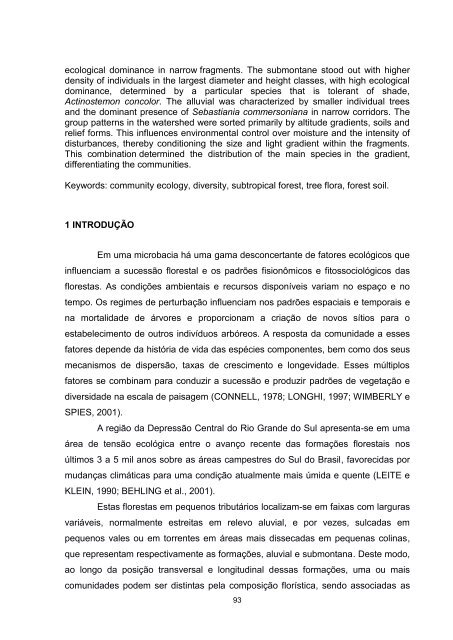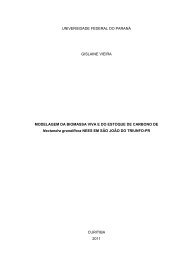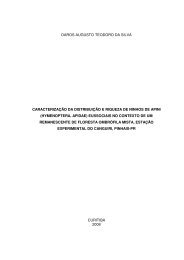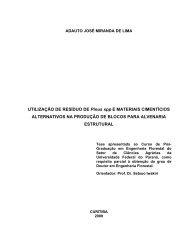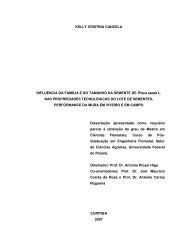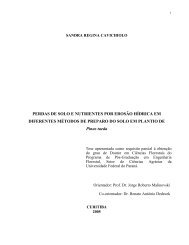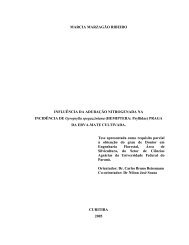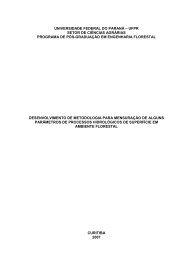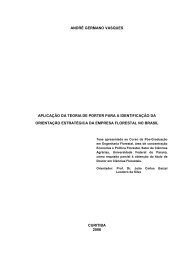Tese em PDF - departamento de engenharia florestal - ufpr ...
Tese em PDF - departamento de engenharia florestal - ufpr ...
Tese em PDF - departamento de engenharia florestal - ufpr ...
Create successful ePaper yourself
Turn your PDF publications into a flip-book with our unique Google optimized e-Paper software.
ecological dominance in narrow fragments. The submontane stood out with higher<br />
<strong>de</strong>nsity of individuals in the largest diameter and height classes, with high ecological<br />
dominance, <strong>de</strong>termined by a particular species that is tolerant of sha<strong>de</strong>,<br />
Actinost<strong>em</strong>on concolor. The alluvial was characterized by smaller individual trees<br />
and the dominant presence of Sebastiania commersoniana in narrow corridors. The<br />
group patterns in the watershed were sorted primarily by altitu<strong>de</strong> gradients, soils and<br />
relief forms. This influences environmental control over moisture and the intensity of<br />
disturbances, thereby conditioning the size and light gradient within the fragments.<br />
This combination <strong>de</strong>termined the distribution of the main species in the gradient,<br />
differentiating the communities.<br />
Keywords: community ecology, diversity, subtropical forest, tree flora, forest soil.<br />
1 INTRODUÇÃO<br />
Em uma microbacia há uma gama <strong>de</strong>sconcertante <strong>de</strong> fatores ecológicos que<br />
influenciam a sucessão <strong>florestal</strong> e os padrões fisionômicos e fitossociológicos das<br />
florestas. As condições ambientais e recursos disponíveis variam no espaço e no<br />
t<strong>em</strong>po. Os regimes <strong>de</strong> perturbação influenciam nos padrões espaciais e t<strong>em</strong>porais e<br />
na mortalida<strong>de</strong> <strong>de</strong> árvores e proporcionam a criação <strong>de</strong> novos sítios para o<br />
estabelecimento <strong>de</strong> outros indivíduos arbóreos. A resposta da comunida<strong>de</strong> a esses<br />
fatores <strong>de</strong>pen<strong>de</strong> da história <strong>de</strong> vida das espécies componentes, b<strong>em</strong> como dos seus<br />
mecanismos <strong>de</strong> dispersão, taxas <strong>de</strong> crescimento e longevida<strong>de</strong>. Esses múltiplos<br />
fatores se combinam para conduzir a sucessão e produzir padrões <strong>de</strong> vegetação e<br />
diversida<strong>de</strong> na escala <strong>de</strong> paisag<strong>em</strong> (CONNELL, 1978; LONGHI, 1997; WIMBERLY e<br />
SPIES, 2001).<br />
A região da Depressão Central do Rio Gran<strong>de</strong> do Sul apresenta-se <strong>em</strong> uma<br />
área <strong>de</strong> tensão ecológica entre o avanço recente das formações florestais nos<br />
últimos 3 a 5 mil anos sobre as áreas campestres do Sul do Brasil, favorecidas por<br />
mudanças climáticas para uma condição atualmente mais úmida e quente (LEITE e<br />
KLEIN, 1990; BEHLING et al., 2001).<br />
Estas florestas <strong>em</strong> pequenos tributários localizam-se <strong>em</strong> faixas com larguras<br />
variáveis, normalmente estreitas <strong>em</strong> relevo aluvial, e por vezes, sulcadas <strong>em</strong><br />
pequenos vales ou <strong>em</strong> torrentes <strong>em</strong> áreas mais dissecadas <strong>em</strong> pequenas colinas,<br />
que representam respectivamente as formações, aluvial e submontana. Deste modo,<br />
ao longo da posição transversal e longitudinal <strong>de</strong>ssas formações, uma ou mais<br />
comunida<strong>de</strong>s pod<strong>em</strong> ser distintas pela composição florística, sendo associadas as<br />
93


